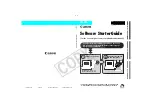
Guidelines for Editing the Configuration File
69
• Comment lines begin with the pound (#) character. Comment lines, blank lines, unknown
parameters, or misspelled parameters are ignored by the server.
• Subsystem-specific parameters are distinguished by a prefix identifying the subsystem as follows:
•
ca
for the Certificate Manager
•
kra
for the DRM
•
ocsp
for the OCSP
•
tks
for the TKS
•
tps
for the TPS
• The parameter names and their values are strings. The parameter names can
be hierarchically structured with periods separating the levels; for example,
ca.Policy.rule.RSAKeyRule.maxSize
. The entries corresponding to a lower level, such as
Policy
in the example, can be requested from the configuration corresponding to its higher level,
ca
in the example.
• The values that need to be localized such as DNs in multibyte format should be entered in
utf8
format.
• The values of some parameters are referenced by other parts of the configuration file.
• The configuration file supports the UNIX-style file separator, the forward slash (/). If the backward
slash (\) file separator is required, use two backward slashes (\\) instead of one.
• Authentication parameters (CA only):
• All authentication-specific information, such as names of registered authentication plug-in
modules and any configured instances, appears in the authentication section of the configuration
file.
• Each registered authentication plug-in module is identified by its implementation name and the
corresponding Java
™
class.
• Each configured instance of an authentication module is identified by the name or ID set when
creating it.
• There can be multiple instances from an implementation; each instance must have a unique
name. To do this, copy all of the parameters belonging to the module used to create the instance.
Change the name of each of these parameters to the new name for this instance, and then
change the values of all the parameters as appropriate.
• The name of an authentication instance must be used in the corresponding certificate profile so
that the server is able to determine the authentication method during end-user enrollment.
• Job Scheduler parameters (CA only):
• All job-specific information, such as registered job modules and configured instances, appears in
the job scheduler section of the configuration file.
• Each registered job module is identified by its implementation name and the corresponding
Java
™
class.
Summary of Contents for CERTIFICATE SYSTEM 7.3 - ADMINISTRATION
Page 15: ...xv Index 525 ...
Page 16: ...xvi ...
Page 38: ...Chapter 1 Overview 16 Figure 1 4 Certificate System Architecture ...
Page 82: ...Chapter 2 Installation and Configuration 60 rpm ev rhpki manage ...
Page 154: ...132 ...
Page 194: ...172 ...
Page 238: ...216 ...
Page 244: ...222 ...
Page 246: ...224 ...
Page 286: ...264 ...
Page 292: ...270 ...
Page 318: ...Chapter 13 Certificate Profiles 296 Parameter IssuerType_n IssuerName_n ...
Page 321: ...Freshest CRL Extension Default 299 Parameter PointName_n PointIssuerName_n ...
Page 398: ...376 ...
Page 412: ...390 ...
Page 472: ...450 ...
Page 506: ...484 ...
Page 528: ...506 ...
Page 546: ...524 ...
















































